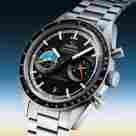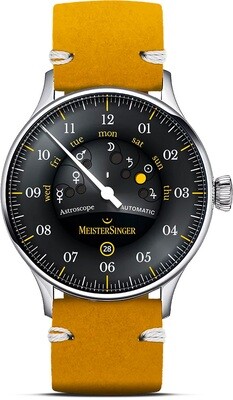With the Stratoscope, MeisterSinger presents the second second model featuring a moon phase display.
And it’s not just the larger case diameter of 43 mm that makes the Stratoscope a completely new concept in terms of design. The powerful, masculine case frames the unusually large moon phase display. The photorealistic image of the earth’s natural satellite corresponds to the astronomical precision with which the Stratoscope represents the moon’s various phases.
In its lower third, the jet black dial merges into a shimmering spectacle of light in varying shades of blue, reminiscent of the aurora borealis visible in the far North. And above this spectacle the luminescent moon circles the earth. The unique scene is transformed into an interplay of light by the hour markers, which also glow, and the luminous needle-shaped hand. The double-digit numerals so typical for MeisterSinger are arranged in a circle from 01 to 12 around the dial, reinforcing the impression of harmony and balance. Despite all this attention to detail, the watch has a crisp, uncluttered appearance.
The moon takes 29 days, 12 hours, 44 minutes, and 2.9 seconds to circumnavigate the Earth. Most watches round this figure down to 29.5 days via the movement, which means they deviate by eight hours per year and need adjusting by one complete day every third year. However, the movement specially designed for the MeisterSinger Stratoscope is far more exact. Its moon-phase indicator only needs a slight adjustment after 128 years.
The workings of the Swiss automatic movement in the Stratoscope equipped with the moon-phase module can be viewed through the screwed glass exhibition back of the 43-millimeter case.







